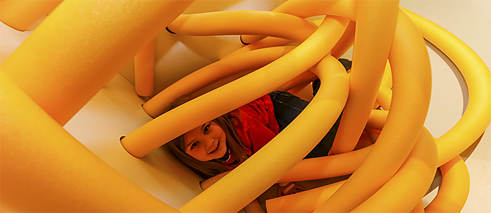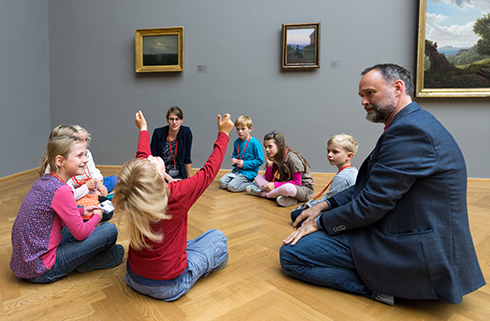The museum as classroom
The new ‘please touch’ museum

Museums are courting children and young people as the clients of tomorrow by offering innovative learning environments where they can interact with art.
By Nadine Berghausen
Educators and museum staff agree that children should be introduced to art at an early age. Museums help achieve this goal, if they are welcoming spaces where little ones can dive into the fantastic and colourful world of art. This isn’t always the case though, and getting kids excited about art takes more than parents hauling the kids to the occasional exhibition. While mum and dad may enjoy learning about the works on display on a guided tour, junior probably cares much less about Impressionism or Expressionism than about the shiny parquet floor that is perfect for sliding. Little ones also tend to struggle with the basics of museum etiquette, and don’t understand why they should “look but don’t touch.”
A museum for children
A child-friendly atmosphere is the best way to get children dipping their toes into the culture on display in a museum. Trained museum educators know all the tricks of the trade and are helping many German museums design programmes to spark children’s interest in the world of art. Kids can now go on special guided tours, take part in workshops and hands-on art courses after school and during the holidays, and celebrate a birthday with a special night of art or a supervised interactive adventure course. And parents are signing their progeny up in droves. The Albertinum in Dresden has hung nine pictures in one room lower to attract their tiny guests.
| Photo (detail): © picture alliance / dpa / dpa-Zentralbild / Monika Skolimowska
Ahead of the pack is Frankfurt’s Schirn Kunstahalle that features children’s programming unique in Germany. “Minishirn” is the name of a children’s wing where pre-school to primary school children can learn while they play. Set apart from the museum’s exhibition areas, the space is like a huge treehouse where kids can clamber through the rooms, exploring shapes and colours, trying their hand at the creative process and experimenting on their own. Unlike in an adult museum, young visitors don’t just look, think, and read; they are encouraged to touch, build and take things apart. Minischirn caters to kid’s natural energy levels, and even very young children can get their wiggles out while experiencing art in the treehouse. “Children need to move about, so we focused on combining physical activity with a playful ways of experiencing basic aesthetic skills,” Chantal Eschenfelder, head of Schirn’s Education and Communication Department, explains.
The Albertinum in Dresden has hung nine pictures in one room lower to attract their tiny guests.
| Photo (detail): © picture alliance / dpa / dpa-Zentralbild / Monika Skolimowska
Ahead of the pack is Frankfurt’s Schirn Kunstahalle that features children’s programming unique in Germany. “Minishirn” is the name of a children’s wing where pre-school to primary school children can learn while they play. Set apart from the museum’s exhibition areas, the space is like a huge treehouse where kids can clamber through the rooms, exploring shapes and colours, trying their hand at the creative process and experimenting on their own. Unlike in an adult museum, young visitors don’t just look, think, and read; they are encouraged to touch, build and take things apart. Minischirn caters to kid’s natural energy levels, and even very young children can get their wiggles out while experiencing art in the treehouse. “Children need to move about, so we focused on combining physical activity with a playful ways of experiencing basic aesthetic skills,” Chantal Eschenfelder, head of Schirn’s Education and Communication Department, explains.Making art accessible to as many visitors as possible, Eschenfelder continues, is a key part of a museum’s mission. To really reach children, you have to understand their interests and cognitive and motor skills at each stage of development.
“Art education means translating topics into the respective target group’s language level.” This is not always easy, since art is rarely designed to speak to children. Eschenfelder is confident that even really challenging ideas can be communicated if you relate it to real-life examples or practical illustrations. There are, she admits, some borderline cases where she would have to structure an exhibit differently to make it accessible to kids.
When it doubt, leave it out
In Germany, the FSK (Freiwillige Selbstkontrolle der Filmwirtschaft or Self-Regulatory Body of the Film Industry) gives films and videos age restrictions to protect children and young people from unsuitable content. There is no comparable system for museums. And there are no nationwide restrictions on how museums present art and make it accessible to the public. Yet there is some art on display that parents would not want their children exposed to, such Abject Art pieces, where artists worked with objects intended to trigger disgust or phobias, or invoke pornography. If your’re lucky, there might be a sign at the entrance warning visitors of potentially offensive material to ward off complaints from sensitive visitors, but museum goers can’t expect much more in the way of information.According to Chantal Eschenfelder, this is because museums would be hard pressed to come up with guidelines that would apply across the board, since parents may have very different ideas about what they want to show their children. “Where do you draw the line between unacceptable censorship and being too permissive? We don’t believe in a schematic definition, something along the lines of ‘this exhibition is only suitable for children of six or older’. That makes no sense in the context of fine art.”
At Minischirn, controversial or very complex material is simply left out when appropriate. Since a lot of parents also take their children to see the regular exhibitions, curators will often take a completely practical approach: Eschenfelder remembers a 2012 exhibit featuring pictures and sculptures by US pop artist Jeff Koons. A simple partition wall blocked the more provocative works from children’s immediate line of sight, leaving it up to parents to decide whether they wanted their children to see what was behind the barrier.